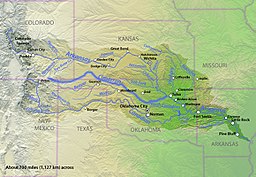Cimarron River (Arkansas River)
| Cimarron River | |
| River | |
|
The Cimarron River, near Forgan, Oklahoma
|
|
| Country | United States |
|---|---|
| States | Colorado, Kansas, New Mexico, Oklahoma |
| Cities | Cushing, Oklahoma, Mannford, Oklahoma |
| Source | Confluence of Dry Cimarron River and Carrizozo Creek |
| - location | Kenton, Cimarron County, Oklahoma |
| - elevation | 4,318 ft (1,316 m) |
| - coordinates | 36°54′24″N 102°59′12″W / 36.90667°N 102.98667°W |
| Mouth | Arkansas River |
| - location | Keystone Lake, at Westport, Pawnee County, Oklahoma |
| - elevation | 722 ft (220 m) |
| - coordinates | 36°10′14″N 96°16′19″W / 36.17056°N 96.27194°WCoordinates: 36°10′14″N 96°16′19″W / 36.17056°N 96.27194°W |
| Length | 698 mi (1,123 km) |
| Basin | 18,950 sq mi (49,080 km2) |
| Discharge | for Guthrie, Oklahoma, 65 miles (105 km) from the mouth |
| - average | 1,163 cu ft/s (33 m3/s) |
| - max | 158,000 cu ft/s (4,474 m3/s) |
| - min | 0.3 cu ft/s (0 m3/s) |
|
Map of the Arkansas River basin with the Cimarron River highlighted.
|
|
The Cimarron River extends 698 miles (1,123 km) across New Mexico, Oklahoma, Colorado, and Kansas. The headwaters flow from Johnson Mesa west of Folsom in northeastern New Mexico. Much of the river's length lies in Oklahoma, where it either borders or passes through eleven counties. There are no major cities along its route.The river enters the Oklahoma Panhandle near Kenton, crosses the southeastern corner of Colorado into Kansas, re-enters the Oklahoma Panhandle, re-enters Kansas, and finally returns to Oklahoma where it joins the Arkansas River at Keystone Reservoir west of Tulsa, Oklahoma, its only impoundment. The Cimarron drains a basin that encompasses about 18,927 square miles (49,020 km2).
The river's present name comes from the early Spanish name, Río de los Carneros Cimarrón, which is usually translated as River of the Wild Sheep (literally, 'River of the Feral Rams'). Early American explorers also called it the Red Fork of the Arkansas because of water's red color. Early explorers and map-makers called it by several other names, including Grand Saline, Jefferson (in John Melish's 1820 U.S. map), Red Fork, Salt Fork, and Salt River.
In New Mexico and extreme western Oklahoma the river is known as the Dry Cimarron River. This is by contrast to a wetter Cimarron River located further west and flows only through New Mexico. The Dry Cimarron River is not completely dry but sometimes its water disappears entirely under the sand in the river bed. The Dry Cimarron Scenic Byway follows the river from Folsom to the Oklahoma border. In Oklahoma the river flows along the southern edges of Black Mesa, the highest point in that state. As it first crosses the Kansas border, the river flows through the Cimarron National Grassland.
...
Wikipedia


